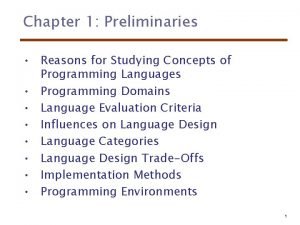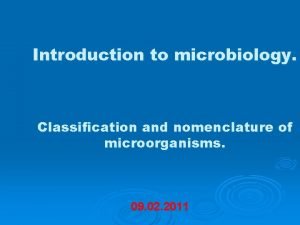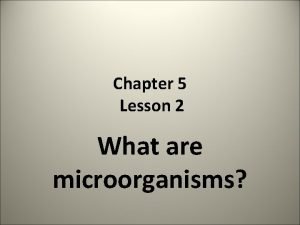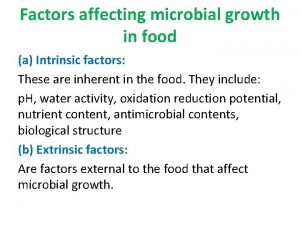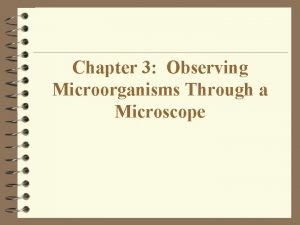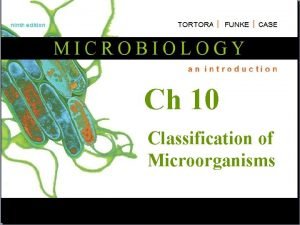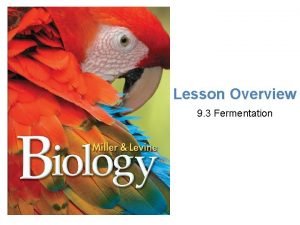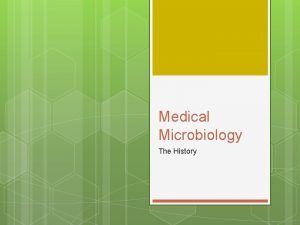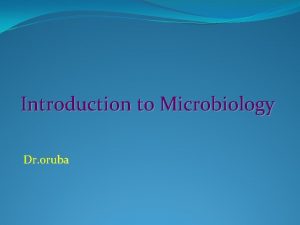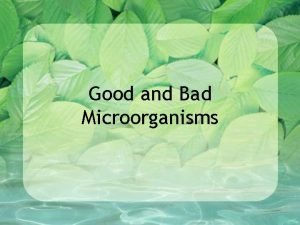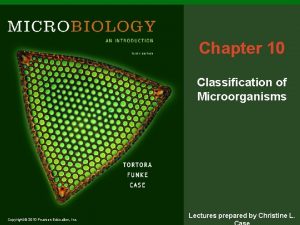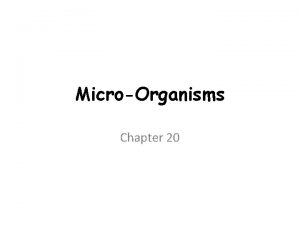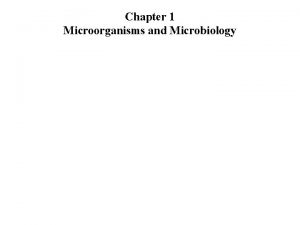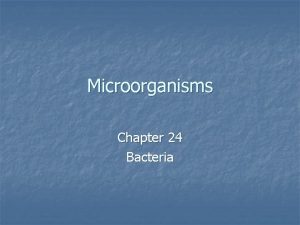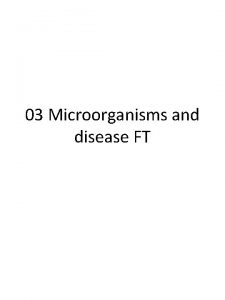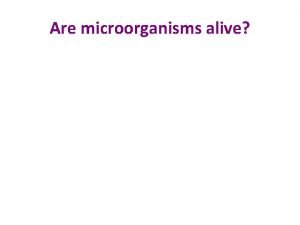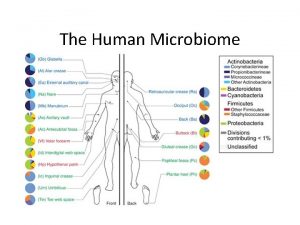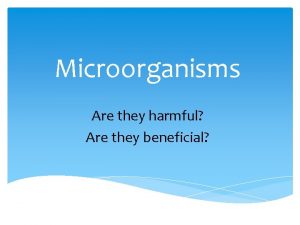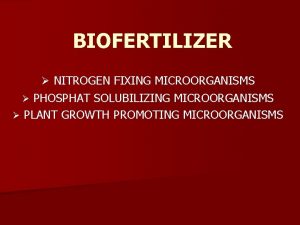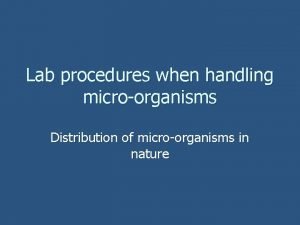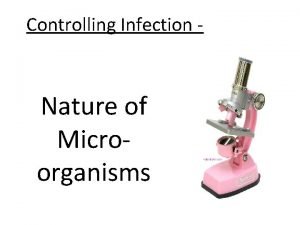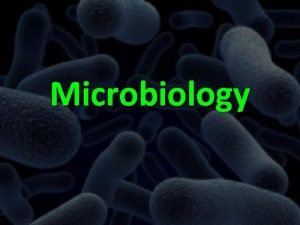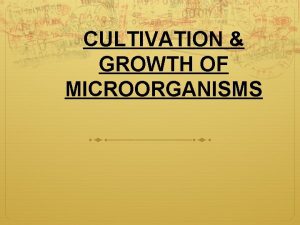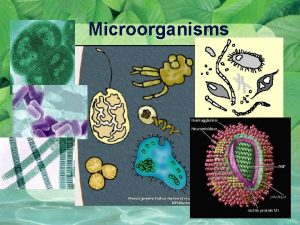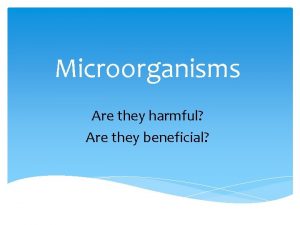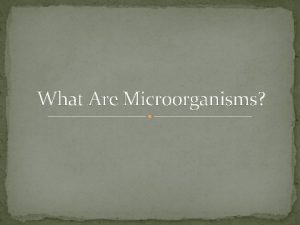Chapter 3 Concepts and Tools for Studying Microorganisms

























- Slides: 25

Chapter 3 Concepts and Tools for Studying Microorganisms

3. 1 The Prokaryotes Are Not Simple, Primitive Organisms Figure 03. 02 A: Staphylococcus aureus. © SPL/Photo Researchers, Inc. § Prokaryote/Eukaryote Similarities • DNA is the hereditary material that controls structure and function • Biochemical reactions are used for growth and energy conversions • Response to stimuli • Reproduce to produce offspring • Adapt from one generation to the next • Interactions with other organisms and their environment

All living organisms share the common properties of life § Homeostasis maintains a stable internal environment § Biofilms interact through a multicellular association • Quorum sensing is a chemical communication and cooperation between cells Figure 03. 03 AB: Cell Communication and Quorum Sensing.

Bacterial and Eukaryotic Cells Share Organizational Patterns • • Genetic organization with DNA in Chromosomes Compartmentation with cell membranes Metabolic organization in the cytoplasm Protein synthesis at ribosomes Figure 03. 05 AB: A Comparison of a Bacterial and Eukaryotic Cell.

Bacterial Complexity: Bacterial cells have processes as complex as in eukaryotes. Figure 03. 02 C: Biofilm. Figure 03. 02 B: Homeostasis concept map. Modified from David G. Davies, Binghamton University, Binghamton NY

Prokaryotes and Eukaryotes: The Similarities in Organizational Patterns § Cell theory: the cell is the fundamental unit of life. § Hereditary information is organized in chromosomes. § Cytoplasm is surrounded by a cell membrane which selectively allows substances in or out of the cell. § Metabolism is the chemical reactions that occur in the cell. § Protein synthesis occurs at the ribosome. Figure 03. 01 Prochlorococcus. © Claire Ting/Photo Researchers, Inc.

Prokaryotes and Eukaryotes: The Structural Distinctions • Eukaryotes have membraneenclosed organelles, some bacteria have microcompartments surrounded by protein. • Protein/lipid transport in eukaryotes is carried out by the endoplasmic reticulum and Golgi apparatus. • Mitochondria perform cellular respiration in eukaryotes, while prokaryotes use the cytoplasm and cell membrane. • Both eukaryotes and prokaryotes can perform photosynthesis. Figure 03. 05 B: Eukaryote cells.

• The eukaryotic cytoskeleton gives the cell structure and transports materials within the cell. • Both eukaryotes and prokaryotes use flagella for motility, though the flagella differ structurally and functionally in the two groups. • Many prokaryotes and eukaryotes have a cell wall to help maintain water balance by osmosis. Table 03. 01: Comparison of Prokaryotic and Eukaryotic Cell Structure.

Similarities Between Mitochondria, Chloroplasts, Bacterial and Microbial Eukaryotes Microinquiry 3 Evolution of Eukaryotic Cells Figure A. 9

3. 2 Classifying Microorganisms Reveals Relationships Between Organisms § Classification attempts to catalog organisms. • Taxonomy is the science of classification, arranging related organisms into categories. § Classification uses a hierarchical system. Table 03. 02: Taxonomic Classification.

Nomenclature gives scientific names to organisms. • In the mid-1700 s, Carolus Linnaeus published Systema Naturae, establishing a uniform system for naming organisms. • Each name includes two words, the genus and the specific epithet that together make up the species name. o Ex) Escherichia coli

§ Kingdoms and Domains: Trying to Make Sense of Taxonomic Relationships • In 1886, Ernst H. Haeckel coined the term “protist” for all microorganisms. § Robert H. Whittaker in 1959 developed the fivekingdom system, giving bacteria their own kingdom. • Plantae • Animalia • Protista • Fungi • Bacteria

The three-domain system places the prokaryotes in separate lineages. • The three-domain system was proposed by Carl Woese, based on data from ribosomal RNA sequences. • The three-domain system includes Bacteria, Eukarya, and Archaea. Figure 03. 07: The Three-Domain System Forms the “Tree of Life”.

Many methods are available to identify and classify microorganisms. • In 1984, Bergey’s Manual of Systematic Bacteriology • Experiments on physical characteristics, biochemistry, serology (antibodies), and nucleic acids can be done to identify microbes. • Molecular taxonomy is bases on sequences of nucleic acids in ribosomal RNA. Figure 03. 08: Micro. Scan panel. Courtesy of Biolog

The dichotomous key can be used identify microbes. Microfocus 03. 03 Tools Dichotomous Key Flow Chart.

3. 3 Microscopy Is Used to Visualize the Structure of Cells Most microbial agents are in the micrometer size range. • Most bacterial and archaeal cells are 1– 5 micrometers (µm) in length. Figure 03. 09: Size comparisons among various atoms, molecules, and microorganisms.

Light microscopy is used to observe most microorganisms. • Visible light passes through multiple lenses and through the specimen. • Light microscopes usually have at least 3 lenses: low-power, highpower, and oil-immersion. • The lens system must have high resolving power to see the specimen clearly. Figure 03. 10 B: Light microscope.

Staining techniques provide contrast. • The simple stain technique involves flooding a prepared specimen with basic dye. • The negative stain technique uses acidic dye, which is repelled by cell walls, leaving clear cells on a dark background. Figure 13. 11 AB: Important staining reactions in microbiology.

• In the Gram stain technique, cells are stained with crystal violet and Gram’s iodine solution and washed with a decolorizer. • Safranin is applied as a counter stain. • Gram-positive bacteria retain the crystal violet, whereas gram-negative bacteria do not. Figure 03. 11 C: Important Staining Reactions in Microbiology.

• Mycobacteria can be stained with carbol-fuchsin in the acid-fast technique. • The red cells are acid-fast as seen in TB. Figure 03. 12 D: Acid-Fast Stain Mycobacterium tuberculosis. Courtesy of Jeffrey Pommerville

Figure 03. 13 A Phase Contrast. Courtesy of Larry Stauffer, Oregon State Public Health Laboratory/CDC • Phase-contrast microscopy a special condenser and objective lenses allow observers to view living, unstained organisms. • Dark-field microscopy shows the specimen against a dark background and provides good resolution. Courtesy of Schwartz/CDC § Light microscopy has other optical configurations. Figure 13. 13 B: Dark Field.

• In fluorescence microscopy, specimens are coated with fluorescent dye and illuminated with ultraviolet light. Figure 03. 14: Fluorescence Antibody Technique.

Electron Microscopy Provides Detailed Images of Cells, Cell Parts, and Viruses. • Electrons are absorbed, deflected, or transmitted based on the density of structures in the specimen. • The practical limit of an electron microscope’s resolution is about 2 nm. Figure 03. 15: the Electron Microscope. Courtesy of Carl Zeiss Microscopy

• The transmission electron microscope visualizes structures in ultrathin section of cells. Figure 03. 16 A: Psedomonas whole cells TEM. © CNRI/Photo Researchers, Inc.

• The scanning electron microscope is used to visualize surfaces of unsectioned objects. Figure 03. 16 B: Psedomonas whole cells SEM. © Dr. Dennis Kunkel/Visuals Unlimited
 The five i's of studying microorganisms
The five i's of studying microorganisms Reasons for studying concepts of programming languages
Reasons for studying concepts of programming languages Four-model approach
Four-model approach Dfd chapter 5
Dfd chapter 5 Flora fauna and microorganisms
Flora fauna and microorganisms Critical thinking concepts
Critical thinking concepts Chapter 24 studying the sun
Chapter 24 studying the sun Lesson 1 studying geography
Lesson 1 studying geography Studying geography economics and citizenship
Studying geography economics and citizenship Learning objectives of microorganisms
Learning objectives of microorganisms The classification schemes of a fungus and a bacterium
The classification schemes of a fungus and a bacterium Are microorganisms helpful or harmful
Are microorganisms helpful or harmful Harmful microorganisms
Harmful microorganisms Intrinsic factors affecting microbial growth in food
Intrinsic factors affecting microbial growth in food Limitations of light microscope
Limitations of light microscope Microorganisms meaning
Microorganisms meaning Microorganisms 5th grade
Microorganisms 5th grade Organism of lactic acid fermentation
Organism of lactic acid fermentation Fermentation in microorganisms
Fermentation in microorganisms Wanted poster microorganism
Wanted poster microorganism What is the microorganisms
What is the microorganisms Classification of microorganisms
Classification of microorganisms Microorganisms
Microorganisms What is the microorganisms
What is the microorganisms Physiology of microorganisms
Physiology of microorganisms Copyright
Copyright

